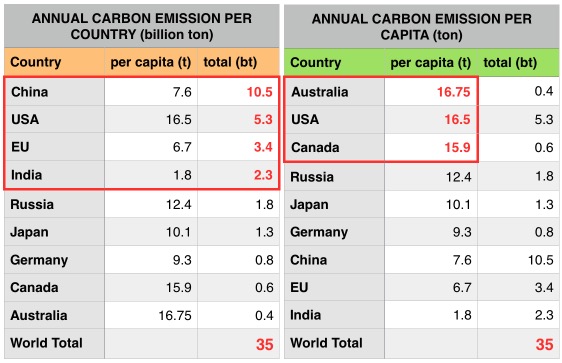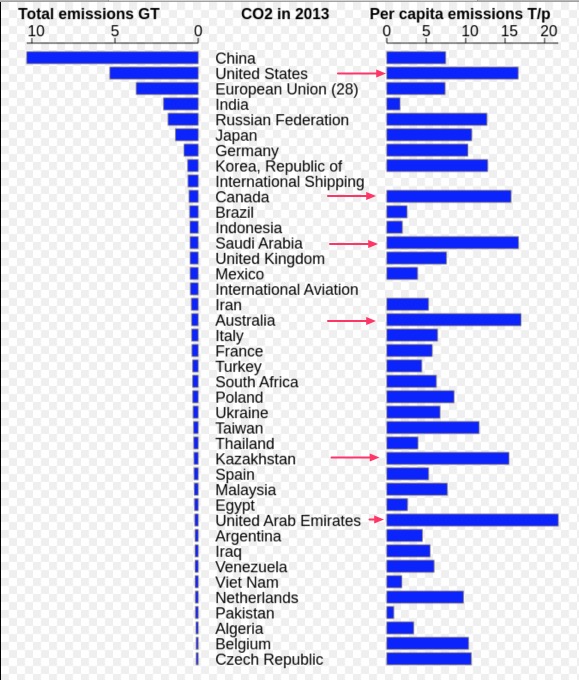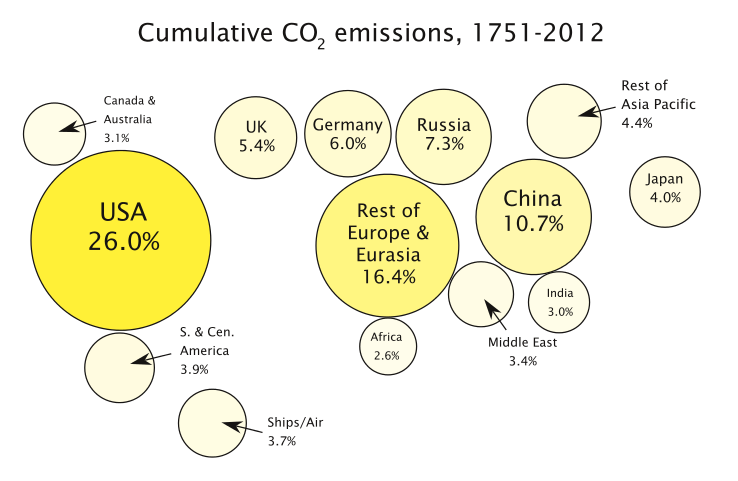I do not believe the Paris Climate talks will produce any result other than a lot of empty talk and photo shoot. Why do I feel that ? Because the world leaders appear to be allergic to calling a spade a spade, and spend their time on obfuscation that to me looks like deliberate attempt to hide the truth from the people who is responsible for the carbon, or total greenhouse gas emission. And the trick is – total emission by nations, and per capita emission by citizens of nations. If you cannot wrap your head around these two figures, you may fail to get to the bottom of this issue.
Here are a few graphs and sources of what I mean.

The above twin chart was made by me, taking CO2 emission figures from Wikipedia, World Bank, World Resources Institute and COTAP. The left half of the chart is what the major leaders would like to talk about – singling out China as the one polluting the planet. The same figures are also at the right half, but sorted according to per capita emission, or how much each person in these countries are emitting. And here you see a different pattern – the Anglo Saxon world is leading the attack on our environment, leading by far in carbon emission. Since these nations, and in particular USA, gives the impression of being among the best country in the world that others should imitate, they are setting the worst possible example for the rest of the planet. And this is something I would like to hear from Malcolm Turnbull, Barak Obama, or Justin Trudeau, And that is exactly what these leaders will not talk about, and will not accept.
Let us look at some more figures. This one is from Wikipedia

The list is sorted according to total emission of CO2 by nation. China is touted to look like the bad guy, having overtaken USA as the single largest CO2 emitting nation. But the bars at the right, give you the per capita figure. I added the red arrow to single out the greatest polluters on a per capita basis. Again, the Anglo saxons stand out as the worst environmental degraders, along with a few countries with easy access to fossil fuel such as Saudi Arabia, Kazakstan and UAE.
Now let us check a chart of total Green House Gas emission (Carbon Dioxide is not the only GHG) per capita, among the ten largest total emitting nations of the world, by World Resources Institute.

I added the red and blue dotted horizontal line and the ellipses around USA and Canada. Notice that the world average emission is just over six (tons per person per year), along the dotted line. This means, if the playing field was made level right now, and the world decided not to increase carbon emission any further than what is today, every one will be allowed to emit only around 6 tons per year. Of course that is not what the world likes to aim at. They would like to limit total green house gas emission to what it was back in 1990. That total figure, of around 37 or so giga tons per year, when divided by the current population, of say 9 billion people, comes to, around 4 tons per person per year. That line was superimposed by the fat blue dotted line by me.
So now, let us see what this means. First, why do folks want to go back to the 1990 total, or reduce emission even less than the 1990 total? That is because folks have figured out that the cumulative effects of global warming and climate instability has a lag period in relation to the greenhouse gas emission. This means, even if every human dies today and stops producing any more CO2, the warming effect would continue for a while, before it begins to fall off. And we are not planning to all die off. Far from it. So, it was decided that going back to 1990 level would be a start. Even achieving that would ensure the world climate would change for the worse, up to a point, and then stay that way and not get any worse.
That was the basis for the 1990 emission level. So, now we understand the issue, and that the world average annual emission, based on 1990 total emission and current world population, should be around 4 tons.
This effectively means, if we really wish to make the playing field level, and that every human on earth is allowed have the same limit of GHG emission, then Canada, for example, will have to learn to do with a sixth of its current level of emission, or say 17% of its current level. And USA, the so called leader of the free world, will have to learn to live with a fifth of its current emission level. Can USA, or Canada, or Australia, manage to go back to energy consumption of a century ago? Can anybody imagine it? I do not see any of our leaders even talk about “per capita” emission, let alone setting any limit. And I know no poorer or developing country is going to accept any level that is lower pollution level than what the rich nations now enjoy. So, as long as the rich and the powerful are not willing to call a spade a spade, the rest of the world has every right to tell the leaders to go fly a kite, even if the outcome is environmental destruction that makes the earth’s surface less habitable by large air breathing vertebrate animals.
Meanwhile, how it is going to be for China, if the limit of 4 tons was to be implemented today ? Well, China will have to cut its own per capita emission to almost half. China is of course not at all ready to do that. In fact, China’s understandable argument or accusation has been that it is the west that caused the problem through four centuries of “development”, and damned if China is going to be penalized for that. China has every right, and will exert that right, to catch up with the west.
What does that mean, in terms of total emission ? If china is to catch up with the west, meaning primarily the anglo saxons (USA, Canada, Australia), it can easily double its per capita emission. That would add at least another 10 giga tons of carbon annually, and increase the global total by a fourth. In short, if the Anglo Saxons do not agree to decimate their emission level, China promises to increase global emission by 25%, from the current total level of around 40 to around 50 giga tons. What would that mean, in terms of average rise in temperature ? I do not know, and would appreciate anyone clarifying that.
Now, what about India? If we are to believe what some of the leaders are saying, it is USA, China, India, EU that are the power blocks. India is not high on total or per capita emission levels. But India is being taken seriously because it has the second highest population and is slated to overtake China as the most populous country soon. Not just that, but India is also an emerging nation, meaning it is recording a faster growth rate going over 7% annually, and its fuel consumption, deforestation, and contribution towards GHG emission is expected to climb exponentially for the coming decades.
Interestingly, among the top ten total emitters of today, in the chart above, only two nations, Mexico and India, have a per capita emission that is lower than the current average, while India is the only one that is below the average based on 1990 level too.
So, if India was to jump from its current low emission to the 1990 average level, there would not be a significant rise in global emission. But, if an agreement is not reached, and India too decides to go like China, and catch up with the Anglo Saxons, it can in essence increase its per capita emission ten fold, and national total by almost 20 giga tons, or 50% of the world total as of today. How much would that translate into a climate crisis ? How much would China+India catching up would cost the world in environmental greenhouse effect ?
Do we, as Canadians, have the right to demand that we continue to burn up 20 tons per man per year, and that China stays at 8 and India stays at 2? Will India or China agree to such a demand? Will USA agree to go back to the stone age with regard to fossil fuel consumption ?
Is anybody talking about these issues? I do not see truth coming from any of our leaders, not even second tier leaders. Not even small party leaders like Elizabeth May of the Green Party.
If we check the cumulative effect of CO2 emission since the dawn of the industrial age, from Dennis Silverman’s Southern California Energy blog, again USA stands out as a major villain, along with Germany, Russia, China. Eurasia, comprising of a rather vast region, and a slew of nations, still comes up with far less cumulative emission in the past two and a half century.
Greenhouse gases might be one out of more than one weapon of mass destruction we have unleashed on the planet – a chemical onslaught being at least one other. And since no leader is at all willing to call a spade a spade, I do not see how the higher planetary life can survive. Our leaders are calling a spade a Micky Mouse.
Whats the matter with the Anglo Saxons?
In general the more developed a nation is, more it has been polluting the environment with GHG. But out of them all, Australia, Canada and USA stand out as particular bad apples. Why? Is it something to do with their ethnicity, or culture, or work view or language, or geography? Well, Geography can be discounted since Australia, USA and Canada do not share identical climate geographic region. I shall let experts ponder this one out, but at first glance, the Anglo Saxons seem to be the least likely to provide a way out of this environmental dead end, because, as an ethnic group, it appears to be the most polluting in the entire planet. Unfortunately, the same anglo saxons also often assume they are in fact the leaders of the world, along with UK of course. Time for us to have a paradigm shift in our thinking, if we are going to solve this problem and get out alive as a civilization.
In general, the world is screwed, and human development and technology are, when you cut it to the bone, responsible for this crisis.
May be the solution would not come from humans at all, but from the micro organisms. I doubt man’s destructive “developmental” habits will be able to harm much of the micro-biota of the planet though. Those nitrogen fixing, oxygen breathing or exhaling, Methane eating, biochemically inventive micro-organisms might collectively produce a feedback loop, and begin to address the climate crisis, like in James Lovelock’s gaia hypothesis.
That, is a whole different story.




